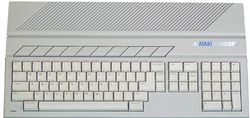Atari ST
The Atari ST, first released in April 1985 by the Atari Corporation, was a direct competitor to the Commodore Amiga and its greatest rival. Both computers represented the next true step up from the previous generation of 8-bit home machines such as the C64 and Atari 800. In an interesting historical turnabout, after Jack Tramiel left Commodore he purchased the Consumer Division of Atari and with the ST found himself in direct competition with his old company, which he had founded and which under his leadership had released the best selling C64.
In some ways the Atari ST was very similar to the Amiga in that it used a Motorola 68000 CPU and had a mouse-driven GUI (Graphical User Interface), but it lacked the Amiga’s specialised sound and graphics chips that made it such a popular games and video editing machine. On the other hand, the ST gained a niche in the DTP (DeskTop Publishing) and CAD (Computer Aided Design) markets, and because it had built-in MIDI ports was used extensively for music production, sequencing in particular, by both amateurs and professionals alike.
The “ST” in the name stood for “Sixteen/Thirty-two”, which described the Motorola 68000’s 16-bit external bus and 32-bit internal instruction set, registers and internal data bus.
Throughout their production runs the Atari ST and Amiga were seen as great rivals, with debates similar to those between aficionados of PC and Apple computers seen today. Then as now both computers had certain advantages and disadvantages, not least based on the kinds of applications available and the tasks that users wanted to use their machines for.
The main ST models were eventually superseded by the Atari STE, TT, MEGA STE and Falcon, but by this time the 16-bit era was beginning to come to an end, with companies focusing on 32-bit computers and games consoles. Atari ceased development of the ST line in 1993 to focus on the Jaguar, its own games console, although this was generally considered to be a failure, as was the Amiga-derived line of consoles. The 16-bit home computer era had come and gone.
Links[edit | edit source]
| Wikipedia: Atari_ST |
